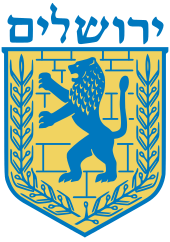Rehavia
Rehavia (also Rechavia) (Hebrew: רחביה, Arabic: رحافيا) is an upscale Jerusalem neighborhood located between the city center and Talbiya.
History
Rehavia was established on a large plot of land purchased in 1921 from the Greek Orthodox Church by the Palestine Land Development Company (PLDC) and the first house was completed in 1924.[1] It was named after Moses’ grandson, “Rehavia”.[1] The area was known at the time as Ginzaria, a native Jerusalem plant. The Jewish National Fund (JNF) bought the land and commissioned the German-Jewish architect Richard Kaufmann to design a garden neighborhood. The land was transferred back to the PLDC in exchange for lands in the Jezreel Valley, but the JNF retained some real-estate in the neighborhood. The Gymnasia Rehavia high school, Yeshurun Synagogue, and the Jewish Agency building were built on this land, overlooking the Old City.[2] Rehavia was modeled after the garden cities of Europe, with an emphasis on the International Style popular at the time.[3]
The first phase, called Rehavia Aleph, was bordered by King George Street to the east, Ramban Street to the south, Ussishkin Street to the west, and Keren Kayemet Street to the north. To preserve the quiet character, the neighborhood association allowed commercial businesses only on the two main roads at the neighborhood's edges. The roads open to traffic were deliberately built narrow, to keep them less busy and thus quieter. The main, tree-lined boulevard which bisected the neighborhood was open to pedestrian traffic only. Later expansion was primarily to the south, in the direction of Gaza Street.
The Prime Minister's Official Residence is the "Aghion House", at the corner of Balfour and Smolenskin streets.
Demographics
When the Ethiopian emperor Haile Selassie was exiled from Ethiopia in 1936, he lived on Alharizi Street. Rehavia became known as a neighborhood of upper-class Ashkenazi Jews, home to professors and intellectuals, particularly émigrés from Germany. Many of the country's early leaders lived in Rehavia: David Ben-Gurion, Israel's first prime minister, who lived on Ben Maimon street;[4] Zionist leader Arthur Ruppin; Menachem Ussishkin, head of the Jewish National Fund; Golda Meir, Israel's fourth prime minister; Daniel Auster, the first Jewish mayor of Jerusalem, and philosophers Hugo Bergmann and Gershon Scholem.[3] Among the government ministers who made their home in Rehavia were Dov Yosef and Yosef Burg.
Landmarks
Landmark buildings in Rehavia include the headquarters of the Jewish Agency for Israel, the windmill on Ramban Street, and the Ratisbonne Monastery.

Gymnasia Rehavia, the country's second modern high school (after Gymnasia Herzliya in Tel Aviv) was built on Keren Kayemet Street in 1928. Yitzhak Ben Zvi, who was to become the second president of Israel, and his future wife, Rachel Yanait, were teachers there.[3]
In the center of historic Rehavia is Yad Ben-Zvi, a research institute established by Ben-Zvi. Jason's Tomb was discovered during construction work on Alfasi Street.
Street names
Most of Rehavia's streets are named after Jewish scholars and poets from the Golden Age of Jewish culture in Spain. Among them are Abravanel, Ben Maimon, Ibn Ezra, Rabbi Moses ben Nachman (Ramban), and Radak.[5][6] A glaring omission is the name of Yehuda Halevy, celebrated physician, poet, and philosopher. Zionist leader Menachem Ussishkin, who lived on Rechov Yehuda Halevy, changed the name of the street to Rechov Ussishkin in honor of his 70th birthday in 1933, and installed new ceramic signs crafted by local Armenian craftspeople.[6] A garden in the neighborhood is named for Yehuda HaLevi's work of philosophy, the Kuzari, and a staircase in Jerusalem's Old City where he was said to have been killed is named for him as well. There are occasional efforts to restore Ussishkin Street to its original name.
Notable residents
- Avraham Burg
- Eliezer Igra
- Emanuel Feldman
- David Flusser
- Haile Selassie, Emperor of Ethiopia
- Moshe Goshen-Gottstein
- Moshe Greenberg
- Danny Neuman
- Benjamin Netanyahu (born 1949), Prime Minister
- Menachem Ussishkin (1863-1941), Zionist leader and head of the Jewish National Fund
- Berel Wein, rabbi
- Daphni Leef, activist
- Reuven Rivlin, President of Israel [7]
- Robert Aumann, Nobel prize winner [8]
- Miriam Naor, President of the Supreme Court of Israel [9]
References
- 1 2 http://www.timesofisrael.com/how-rambans-desolate-jerusalem-area-transformed-into-yekkes-rehavia/
- ↑ "Rehavia & Makor Haim". Jewish Virtual Library. 2011. Retrieved 26 February 2011.
- 1 2 3 "Focus on Israel: Jerusalem – Architecture in the British Mandate Period". Israel Ministry of Foreign Affairs. 1 July 1999. Retrieved 26 February 2011.
- ↑ Pfeffer, Anshel (27 March 2008). "Bible club founded by Ben-Gurion gets revived with a Peres twist". Haaretz. Retrieved 26 February 2011.
- ↑ Rubinstein, Danny (26 November 2006). "A walk across Jerusalem history". Haaretz. Retrieved 26 February 2011.
- 1 2 Kurtz, Chani. "Road of Remembrance: Street names and their stories". Binah Pesach supplement, 2015, p. 54.
- ↑ http://www.ynetnews.com/articles/0,7340,L-4528829,00.html
- ↑ http://www.jpost.com/Features/Hes-got-game
- ↑ http://www.haaretz.com/news/features/.premium-1.637316
External links
| Wikimedia Commons has media related to Rehavia. |
Coordinates: 31°46′28.11″N 35°12′43.19″E / 31.7744750°N 35.2119972°E
